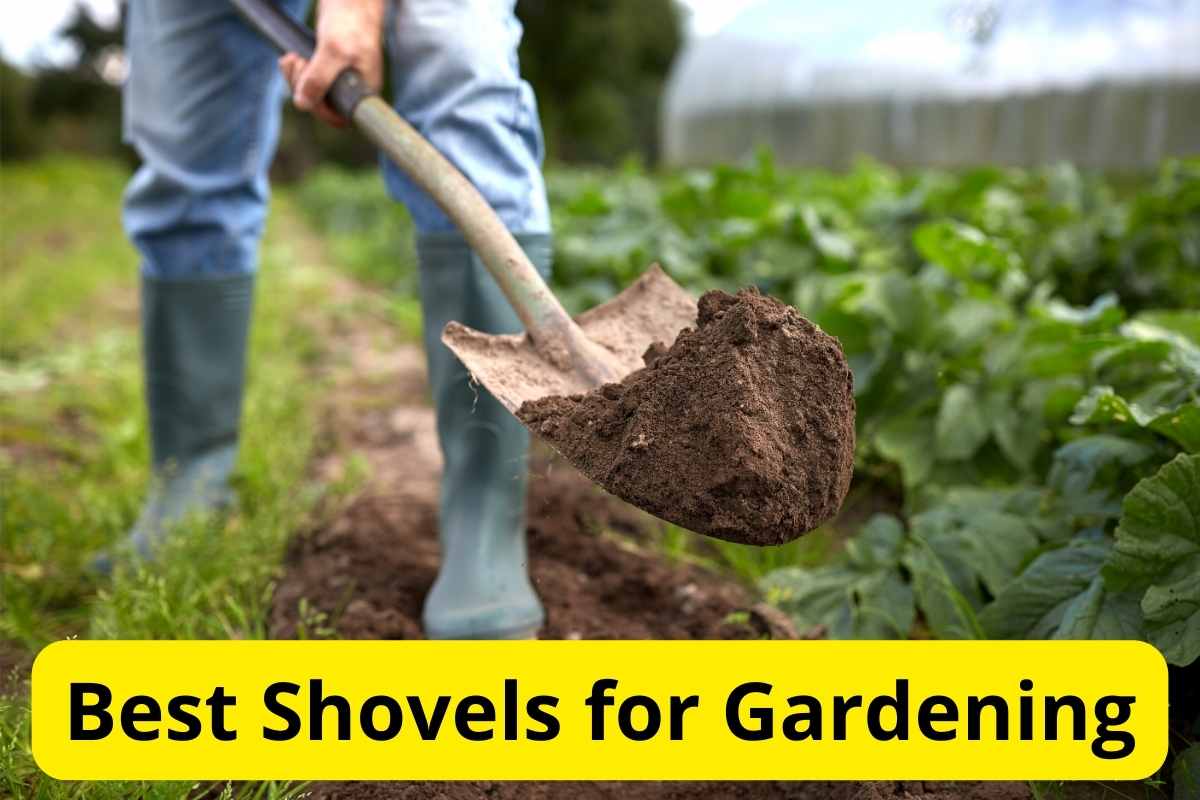
Every gardener needs a shovel. But with so many shovel designs available, how do you find the right tool for your vegetable patch? We have the inside scoop on the eight best shovels for gardening and how to find the most suitable one for the task.
And you needn’t dig too deep –– we’ve uncovered the gritty details for you. From blade material to tool weight, we’ve compared the specifications of dozens of shovels. Our top picks include the best round point, square point, trench, transfer, drain, and mini shovel.
And remember, the best shovel for you might not be the best shovel for your neighbor. Our buyers guide will help you identify the qualities of a great shovel that meets your needs. Let’s get digging!
Top 8 Garden Shovels – Reviews
1. Best Round Point Digging Shovel: Fiskars Steel D-handle Digging Shovel
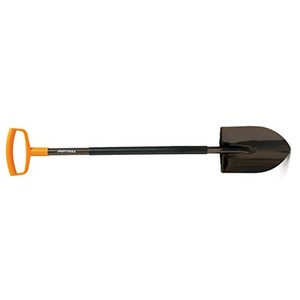
Fiskars Steel D-handle Digging Shovel
Fiskars steel D-handle digging shovel features a durable design that provides excellent grip when you are digging in the garden.
If you’re looking for a single, all-purpose shovel for the garden, the Fiskars D-handle Digging Shovel is the first place to look. It has a 16-gauge hardened steel blade and an 18-gauge steel shaft for optimal durability and long-lasting performance. Compared to fiberglass and hardwood handles, steel takes home the gold medal for durability.
This 46-inch shovel also features a large D-grip handle for enhanced user comfort and control when digging. Its step platform provides a surface for you to push down with your feet instead of using too much upper body strength.
Specifications:
Blade Material: Steel
Handle Material: Steel
Weight: 5 lbs
Pros:
✓ Steel blade and handle means extra durability
✓ D-handle increases user comfort and control
✓ Oversized step provides a comfortable surface for feet
✓ The shovel is powder-coated to prevent rust
Cons:
✗ 46 inches might not be long enough for tall gardeners
2. Best Square Point Digging Shovel (Tie): Bully Tools 82525
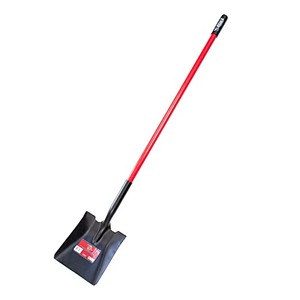
Bully Tools 82525
Bully Tools fiberglass shovels utilize a triple wall fiberglass, wood reinforced handle design.
A square-point digging shovel is an excellent tool for scooping soil and mulch, shaping flower beds, and leveling off areas. The Bully Tools 82525 tied for first place as the best square point digging shovel. It boasts a welded I-beam construction that prevents bending along the ferrule, wood reinforced fiberglass handle, and a 14-gauge steel blade.
This handy shovel also features a closed-back design, which helps prevent debris from sticking to the blade’s back. Why is this important? Reducing the collection of debris helps minimize the unnecessary weight that can quickly tire out the muscles.
Specifications:
Blade Material: Steel
Handle Material: Fiberglass
Weight: 4.9 lbs
Pros:
✓ Welded I-beam construction helps prevent bending along the ferrule
✓ 14 gauge steel blade
✓ Triple wall fiberglass, wood reinforced handle design
✓ Closed-back design minimizes debris buildup
✓ Has a step for foot placement
Cons:
✗ Some users report the shovel does not appear to be high-quality
✗ A fiberglass handle is not as durable as a steel handle.
3. Best Square Point Digging Shovel (Tie): AMES 25337100
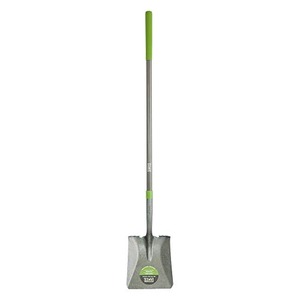
AMES 25337100
This shovel is suitable for frequent jobs, such as transferring dirt, mulch, or gravel.
The Ames 25337100 tied first for best square point digging shovel. It’s slightly more expensive than the Bully Tools 82525 square digging shovel (note that prices are subject to change), but it’s more than a half-pound lighter. After hours of repetitive digging in the garden, you’ll be glad you bought a lighter tool for a few extra bucks.
The Ames 25337100 has a tempered steel blade, steel-reinforced fiberglass handle, and cushioned end grip for enhanced user comfort.
Specifications:
Blade Material: Steel
Handle Material: Fiberglass
Weight: 4.2 lbs
Pros:
✓ Tempered steel blade
✓ Steel reinforced fiberglass handle
✓ Cushioned end grip
✓ Has a step for foot placement
✓ The shovel is 61 inches long
Cons:
✗ Expensive
✗ Some users report hearing a cracking noise when using the shovel
✗ A fiberglass handle is not as durable as a steel handle.
4. Best Trench Shovel: Truper 33436
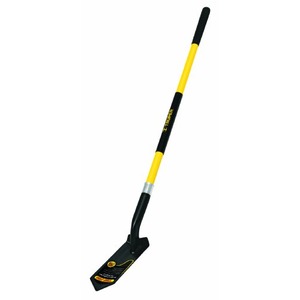
Truper 33436
This shovel is great for digging small trenches to control drainage and flooding.
The Truper 33436 is a terrific shovel for digging trenches in your garden or yard. Building a narrow trench is a control method for drainage and flooding.
Users praise the Truper 33436 for making digging a breeze. The lightweight tool features a 48-inch long handle, a soft cushion grip, and a 14-gauge steel blade.
Bonus points: The rivetless collar solidly connects to the fiberglass handle, which means you won’t have to fidget with loose rivets that can compromise the tool’s durability.
Specifications:
Blade Material: Steel
Handle Material: Fiberglass
Weight: 3.33 lbs
Pros:
✓ Soft cushion grip
✓ Has a step for foot placement
✓ Rivetless, crimped-steel collar
✓ Lightweight
✓ 14 gauge steel blade
✓ Fiberglass handle
Cons:
✗ Some users report the trenching shovel breaks after a few uses
✗ A fiberglass handle is not as durable as a steel handle.
5. Best Transfer Shovel: Fiskars Ergo D-handle Steel Transfer Shovel
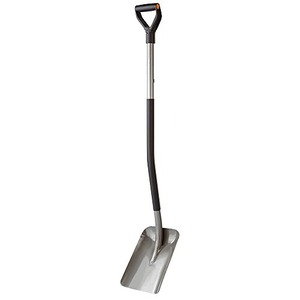
Fiskars Ergo D-handle Steel Transfer Shovel
This shovel’s ergonomic design makes shoveling and spreading garden materials easier than ever.
When you need to move large amounts of loose materials with minimal spilling, such as soil, mulch, or gravel, consider the advantages of the Fiskars Ergo D-handle Steel Transfer Shovel.
The repetitive up and down motion of moving materials can get quite tiresome. That’s why the Fiskars Transfer Shovel shows off a D-handle and mid-handle grip for optimal comfort and control.
This shovel’s high-quality performance is due to its welded boron steel blade and steel shaft.
Specifications:
Blade Material: Steel
Handle Material: Steel
Weight: 4.48 lbs
Pros:
✓ Powder-coated steel resists rust
✓ D-handle and mid-grip enhance comfort and control
✓ Welded boron steel blade
✓ Steel handle
Cons:
✗ Expensive
6. Best Drain Shovel (Tie): Ashman Drain Spade
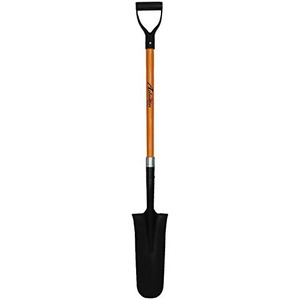
Ashman Drain Spade Shovel
The Ashman Drain Spade tied for first as the best drain shovel.
The Ashman Drain Spade tied for first as the best drain shovel. What is a drain spade? A drain spade is an excellent tool for clearing out trenches and digging in tight spaces. The Ashman Drain Spade features a steel blade and a 48-inch long fiberglass handle.
Weighing in at only 3.7 pounds, this garden tool’s lightweight design is sure to give your tired muscles a break.
Specifications:
Blade Material: Steel
Handle Material: Fiberglass
Weight: 3.7 lbs
Pros:
✓ Steel blade
✓ Fiberglass handle
✓ Has a step for foot placement
✓ Lightweight
✓ Ergonomic D-handle grip
Cons:
✗ A fiberglass handle is not as durable as a steel handle.
7. Best Drain Shovel (Tie): Truper 31285
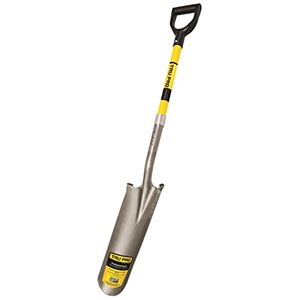
Truper 31285 Tru Pro 16-Inch Drain Spade with Fiberglass D-Handle
The Truper 31285 is another drain shovel to consider for the garden.
The Truper 31285 is another drain shovel to consider for the garden. Measuring 29 inches, it offers a more compact design than the Ashman Drain Shovel.
Although slightly heavier and more expensive than the Ashman Drain Spade, the Truper 31285 boasts a rivetless, crimped-steel collar ring that solidly connects the neck and handle. It also has a reinforced resin insert in the handle that provides 400 pounds of handle strength.
Specifications:
Blade Material: Steel
Handle Material: Fiberglass
Weight: 3.83 lbs
Pros:
✓ 14-gauge steel blade
✓ D-handle grip
✓ Fiberglass handle
✓ Has a step for foot placement
✓ Compact design (measures 29 inches)
✓ Rivetless, crimped-steel collar ring solidly connects the neck and handle
✓ Reinforced resin insert in the handle provides 400-lbs of handle strength
Cons:
✗ A fiberglass handle is not as durable as a steel handle.
✗ Slightly heavier and more expensive than the Ashman Drain Spade
8. Best Mini-Shovel: Z & G Shovel
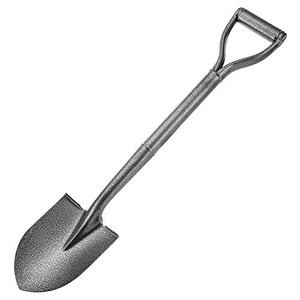
Z & G Shovel
This mini-shovel is rust-resistant, lightweight, and great for digging in tight spaces.
Long-handled shovels are typically best for the garden, but if you need to dig in a tight space, a mini-shovel can do the trick. The Z & G mini D-handle shovel takes home the blue ribbon for the best miniature shovel.
A few highlights: This shovel has a rust-resistant design and all-steel construction. Weighing only 2.29 pounds, its lightweight and compact design makes it a great tool to pack for a camping trip.
Specifications:
Blade Material: Steel
Handle Material: Steel
Weight: 2.29 lbs
Pros:
✓ Steel handle
✓ Steel blade
✓ D-handle grip
✓ Affordable
✓ Lightweight
✓ Has a step for foot placement
Cons:
✗ Some users report the shovel has manufacturing imperfections in its all-metal construction.
Buyers Guide
Buying a shovel might seem straightforward. But many factors determine a shovel’s quality and performance, such as materials, design, and how it feels in your hands. Our buyers guide below covers many factors to consider before opening your wallet for a new gardening shovel.
Shovel Type
There are many different types of shovels for various jobs. Depending on the tasks you have around the home, you might even leave the store with more than one shovel.
These are some of the most common shovel types:
Round Point Digging Shovel
The round point shovel is the standard shovel that often comes to mind when we think of shovels. This shovel type is great for digging holes in the landscape.
You can also use it to transfer loose materials, such as mulch, soil, or gravel, but a square point digging shovel or transfer shovel might fare better with that task.
Square Point Digging Shovel
A square point shovel has a square-shaped blade that can hold more loose materials than a round point digging shovel. How to use this shovel: You can use this shovel to define holes, divide perennials, level surfaces, and edge the landscape.
Trench Shovel
A trench shovel is an ideal tool for building trenches. The shovel has a long narrow blade with a pointed end that slices through the soil with ease.
The blade’s flat sides help create defined walls for your trenches. Sometimes trench blades have serrated edges that help sever stubborn roots.
Transfer Shovel
Also known as a scoop shovel, a transfer shovel has a large square blade with curved edges. Although not ideal for digging, this shovel is a solid tool for transferring materials and typically holds more materials than a round or square point shovel.
You can use a transfer shovel as a snow shovel as well.
Drain Shovel
A drain shovel is shaped similar to a trench shovel, only the blade’s edges are slightly curved. The purpose of a drain shovel is to clear out trenches without disturbing the walls.
Mini Shovel
Don’t want to carry around a long, heavy shovel? A mini shovel can help ease the burden. A small shovel is ideal for light-duty projects or digging in small spaces.
Length
Shovel handles vary in length. An ideal shovel length allows you to bend with your knees while keeping your back straight. If you find yourself bending and twisting your back while digging, the shovel handle might not be long enough for you.
Tall gardeners will typically need a long shovel. Shopping in-person for a garden shovel can help you discover the most comfortable shovel length.
Comfort
Many shovels have a D-shaped handle or cushioned grip near the shaft’s end. D-handles grant the user comfort and control, which can come in handy after hours of work. Cushioned grips also provide comfort for aching hands.
Weight
Buying a lightweight shovel does not mean you are sacrificing quality.
A heavy shovel might feel like a powerhouse, but it will leave your muscles sore and tired after a few repetitive movements. Many of the best shovels on the market have high-quality materials coupled with a lightweight design.
Handle Material
The three most common handle materials are wood, fiberglass, and steel. Let’s take a closer look at how they differ:
Wood: Many gardeners like the look and feel of natural wood. Wood handles are strong, but they’re not as durable as fiberglass or steel. Leave your shovel out in the rain or in a damp storage area, and you’ll see your wooden handle grow mold and rot.
The best woods for a shovel handle are ash and hickory. Shovels made of unspecified “hardwood” might contain low-quality woods.
Fiberglass: This lightweight, durable, shock-absorbing material is –– unlike wood –– not susceptible to water damage or rot.
Steel: Steel is the best choice for gardeners looking for a heavy-duty shovel. It’s stronger than wood and fiberglass, but it is the heaviest and least shock-absorbing material.
Blade Material
Most garden shovel blades are aluminum or steel. Steel takes home the prize for the best shovel blade material, but it’s typically more expensive than aluminum.
Steel blades are stronger and more durable than aluminum. The disadvantage of steel is that it is not rust-resistant. However, some models have rust-resistant coatings.
When shopping for a steel shovel, you’ll notice that most blades are either forged or stamped steel. Forged steel creates higher-quality blades ideal for professional use.
Aluminum blades are more likely to bend and dent than steel. But unlike steel, aluminum does not rust.
Ferrule
The ferrule is the long metal collar that connects the blade to the shaft. Most ferrules are connected to the shaft with rivets, which are susceptible to loosening.
Rivetless ferrules provide the strongest connection between blade and shaft. These ferrules are pressed down or crimped to the handle so tightly that rivets are unnecessary.
Step
Most shovel blades have a small platform that lets you press the blade down with your foot. Some blades have larger step platforms than others, so it’s smart to test various blades to see what feels most comfortable for your feet.
Avoid buying a shovel that has no step; otherwise, your digging experience will be uncomfortable.
Closed vs. Open Back Blades
Many shovel blades have an open back between the blade and the shaft. The open back will often fill up with debris and add weight to your shovel. Debris buildup is common when working with clay soil.
To avoid the additional weight accumulating behind the blade, shop around for a closed-back shovel.
How We Measured
Curious how we found the eight best shovels for gardening? After searching the market high and low, we ranked each shovel in several different categories. We then took a weighted average of their ranked scores to determine the top shovels.
How we ranked the round point, square point, trench, drain, and mini shovel:
- Is the shovel blade forged steel? (Yes or No): 20%
- Blade material (in order from best to worst: steel, aluminum, poly): 20%
- Shaft material (in order from best to worst: steel, aluminum, fiberglass, hickory, ash, hardwood): 20%
- Does the shovel have a rivetless ferrule? (Yes or No): 15%
- Does the shovel have a step platform? (Yes or No): 10%
- Does the shovel have a cushioned or ergonomic grip? (Yes or No): 5%
- Weight (the lighter, the better): 5%
- Cost: 5%
How we ranked the scoop shovel:
Because a scoop shovel doesn’t have a step platform on its blade, we gave it a slightly different ranking system:
- Is the shovel blade forged steel? (Yes or No): 20%
- Blade material (in order from best to worst: steel, aluminum, poly): 20%
- Shaft material (in order from best to worst: steel, aluminum, fiberglass, hickory, ash, hardwood): 20%
- Does the shovel have a rivetless ferrule? (Yes or No): 15%
- Does the shovel have a cushioned or ergonomic grip? (Yes or No): 10%
- Weight (the lighter, the better): 10%
- Cost: 5%
FAQ About Garden Shovels
Although it’s common to use the terms interchangeably, a shovel and a spade are two different gardening tools.
A shovel’s blade curves inward and is optimal for digging. A spade has a flat blade with straight edges. A spade’s blade is in line with the shaft, while a shovel’s blade is typically attached to the shaft at an angle.
Garden spades are best for cutting into sod, building straight-edged trenches, or edging.
If you’re experiencing back pain while shoveling, you might not be using the tool correctly. Most of your power should come from your legs instead of your arms and back.
Check out the helpful instructional video at the end of the FAQ by “Home & Garden for Mere Mortals” on how to use a shovel the right way.
Different types of shovels can help you with various tasks around the garden. Depending on what you need a shovel for, you might want to own more than one. For example, a round point digging shovel is a great all-purpose shovel, but it might not perform as well as a shovel designed for the task at hand.
When to Call a Professional
No gardener should go without at least one shovel. From building trenches to transferring materials, a shovel is a handy tool in the garden and all around your yard.
Our buyers guide covers our top eight picks for best shovels for gardening, but keep in mind that the best shovel for you might not be the best shovel for someone else. There are many items to consider before buying your new shovel, such as the shovel’s material, length, and blade shape.
Don’t have time for trenches or transplanting? Hire a local landscaping professional to take care of the job. Spend less time digging in the garden and more time smelling the roses.
LawnStarter participates in the Amazon Services LLC Associates Program and other retailer affiliate programs. LawnStarter may earn revenue from products promoted in this article.
Main Image Credit: Syda Productions / Canva Pro / License wih Text Overlay using Canva Pro
![16 Best Gardening Tools [Reviews] Gardening Tools on a surface with text overlay on it](https://www.lawnstarter.com/blog/wp-content/uploads/2021/11/Best-Gardening-Tools.jpg)
![9 Best Garden Spades of 2025 [Reviews] spade in a gardening yard with text overlay on it](https://www.lawnstarter.com/blog/wp-content/uploads/2021/08/Best-Garden-Spades-1.jpg)

![6 Best Garden Hoes of 2025 [Reviews] woman gardening in a lawn with text overlay on it](https://www.lawnstarter.com/blog/wp-content/uploads/2021/06/Best-Garden-Hoes.jpg)
![10 Best Pruning Shears of 2025 [Reviews] person using pruning shears with text overlay on it](https://www.lawnstarter.com/blog/wp-content/uploads/2021/06/Best-Pruning-Shears.jpg)